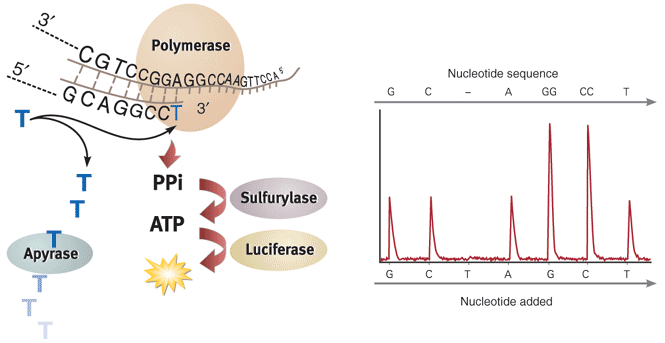


 النبات
النبات
 الحيوان
الحيوان
 الأحياء المجهرية
الأحياء المجهرية
 علم الأمراض
علم الأمراض
 التقانة الإحيائية
التقانة الإحيائية
 التقنية الحيوية المكروبية
التقنية الحيوية المكروبية
 التقنية الحياتية النانوية
التقنية الحياتية النانوية
 علم الأجنة
علم الأجنة
 الأحياء الجزيئي
الأحياء الجزيئي
 علم وظائف الأعضاء
علم وظائف الأعضاء
 الغدد
الغدد
 المضادات الحيوية
المضادات الحيوية|
Read More
Date: 11-12-2020
Date: 17-5-2021
Date: 7-3-2021
|
Pyrosequencing
Rapid PCR sequencing has also been made possible by the use of pyrosequencing, which can be regarded as a second-generation sequencing method without the need for cloning in E. coli or any host cell. In one format of pyrosequencing, a PCR template is hybridised to an oligonucleotide and incubated with DNA polymerase, ATP sulfurylase, luciferase and apyrase. During the reaction, the first of the four dNTPs are added and, if incorporated, release pyrophosphate (PPi), hence the name ‘pyrosequencing’.
The ATP sulfurylase converts the PPi to ATP, which drives the luciferase-mediated conversion of luciferin to oxyluciferin to generate light. Apyrase degrades the resulting component dNTPs and ATP. This is followed by another round of dNTP addition. A resulting pyrogram provides an output of the sequence. The method provides short reads very quickly and is especially useful for the determination of mutations or discovery of single nucleotide polymorphisms .
Another pyrosequencing format involves direct analysis of DNA fragments and this system allows the rapid sequencing of entire genomes by the ‘shotgun’ approach. First genomic DNA is randomly sheared and ligated to linker sequences that permit individual molecules captured on the surfac of a bead to be amplified while isolated within an emulsion droplet. A very large collection of such beads is arrayed in the 1.6 million wells of a fibre-optic slide. The micro-array is presented sequentially with each of the four dNTPs and the amount of incorporation is monitored by luminometric detection as before. The second-generation Roche 454 Genome Sequencer FLX is reportedly able to produce 100 Mb of sequence with 99.5% accuracy for individual reads averaging over 250 bases in length. Once again, the derived sequences can be downloaded automatically to databases and manipulated using a variety of bioinformatics resources.




|
|
|
|
دخلت غرفة فنسيت ماذا تريد من داخلها.. خبير يفسر الحالة
|
|
|
|
|
|
|
ثورة طبية.. ابتكار أصغر جهاز لتنظيم ضربات القلب في العالم
|
|
|
|
|
|
|
العتبة العباسية المقدسة تستعد لإطلاق الحفل المركزي لتخرج طلبة الجامعات العراقية
|
|
|